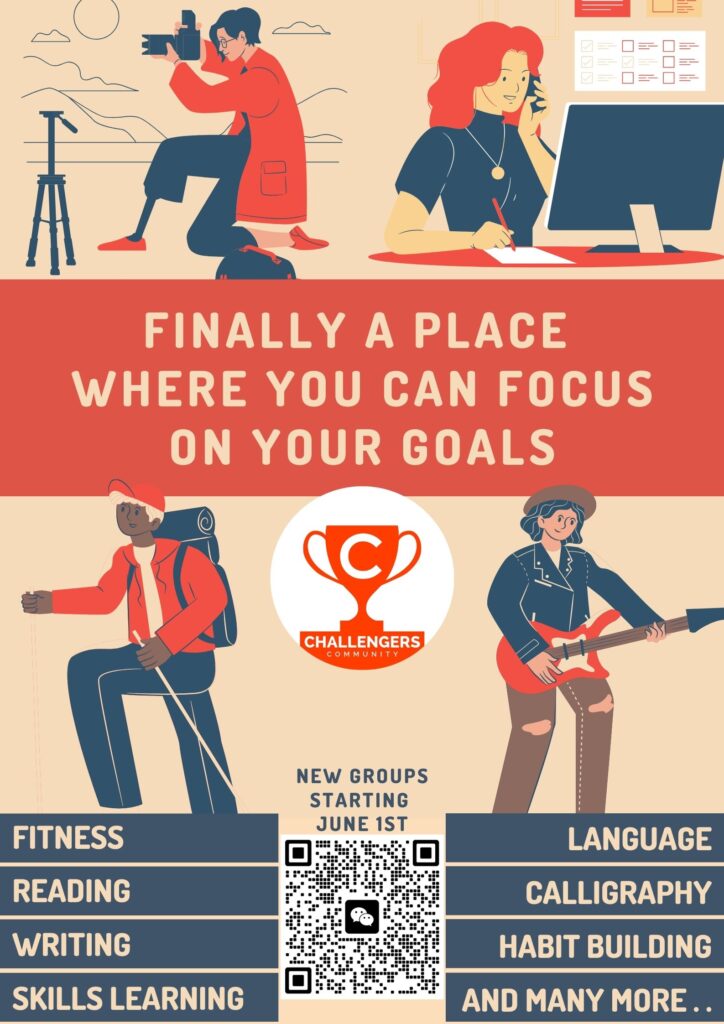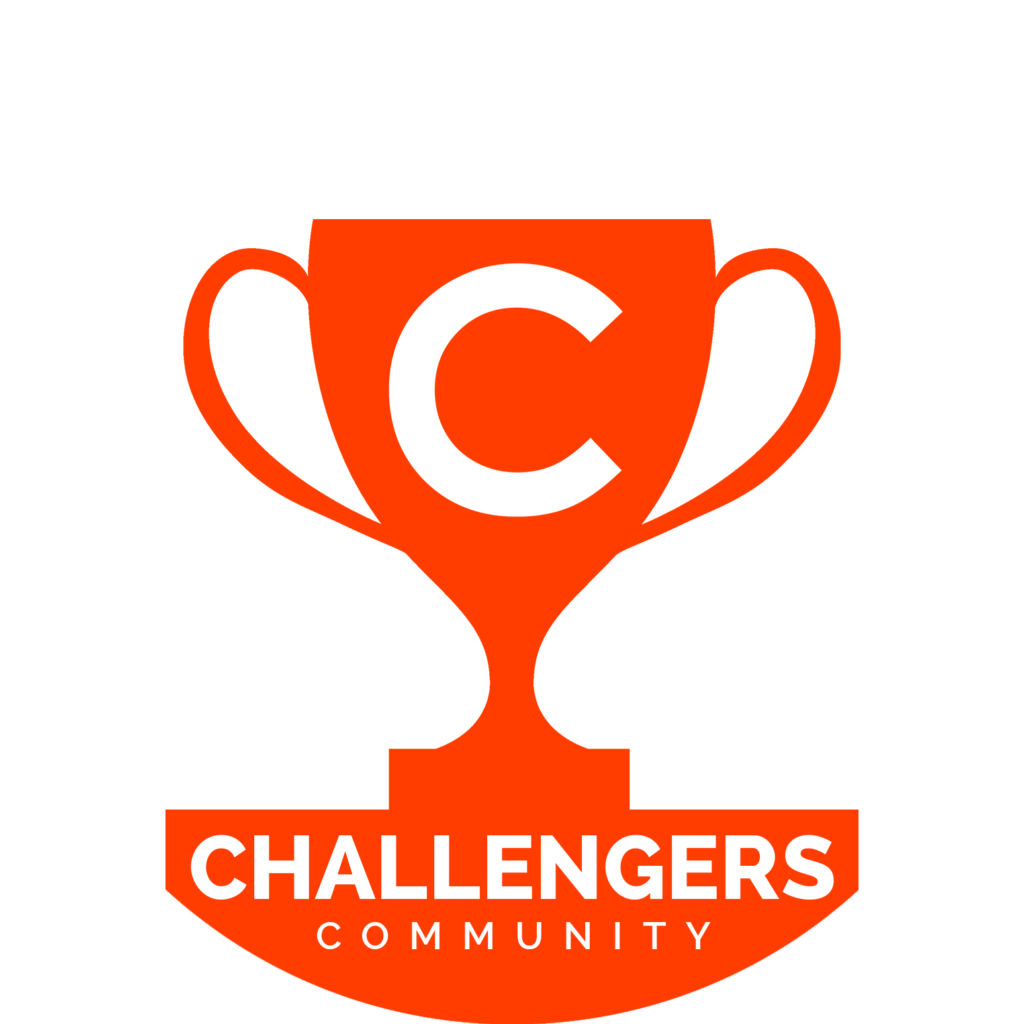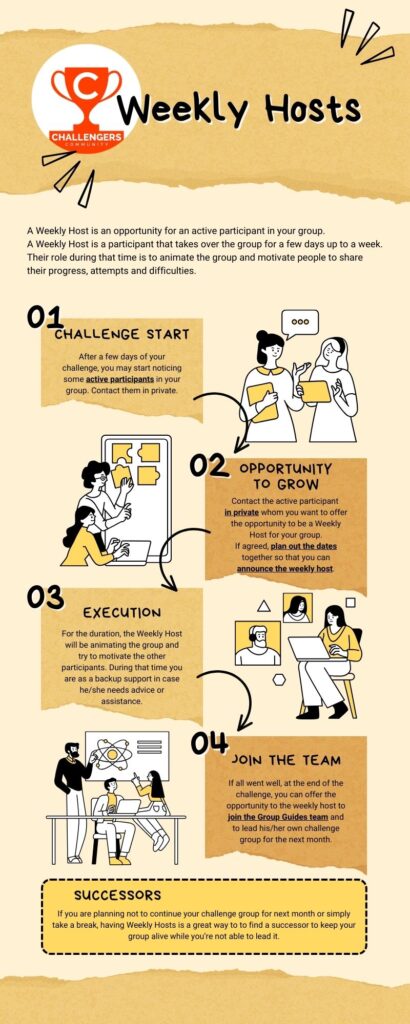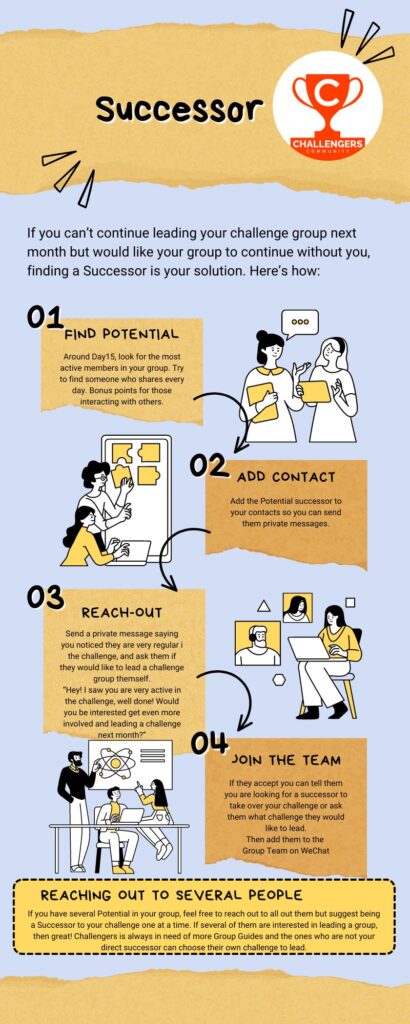Hello Amazing Group Guide. This page is dedicated to you and to help you manage the difficulties related to leading a group.
You’ll find the video and transcription (depending is you prefer to read or listen) and the existing posters and infographics related to each topic.
Table of Content
- Intro
- Creating a group
- Creating a poster
- Starting the Challenge
- No observers
- How to boost your group
- Weekly hosts
- Successors
Intro
Welcome amazing group guides!
Welcome and thank you.
Group guides are the heart and soul of Challengers Community.
And by volunteering of being a group guide, you are helping the community and you are helping so many people to achieve their goals.
You are the reason why Challengers exists.
So what is a group guide exactly?
First of all, Challengers Community is a safe place for people to finally take actions towards their goal.
And as a group guide, you offer the opportunity for people to take action.
Challengers has only one role, no observers. All the rest is your domain.
You create your group, you are the owner of the group.
You can decide of the theme, the frequency of the check-ins, the size limit and everything else.
Your group is your domain.
I will be there as a backup support if you ever need, but normally I don’t intervene or take action into your group.
Your role as a group guide is to encourage people to share their progress, their difficulties.
Every sharing is a step forward towards creating a new habit and building a new skill.
You do not need to be an expert. In fact, most of the group guides are here to learn as well at the same level as any other participant.
By being a group guide, you will gain a lot of various experience.
The most that comes out from asking existing group guides is they gain a lot in human interaction, in human experience.
They gain a lot in group management, and most of all is they gain a lot in having an extra boost into their personal goal achievement.
I’m super excited to have you here.
Check out the other tutorials to help you get a little bit more acquainted with your role as a group guide and what to do when you meet certain difficulties or obstacles.
Creating a group
Creating a poster
Here is a demo on how to make a poster using Canva.com. If you have another app/system you prefere, feel free to use what you are most comfortable with.
Starting the Challenge
Hello our amazing group guide!
We’re going to talk about getting started into your group.
So you’ve already done a poster and you’ve already created your group.
Now, how do you get started into your group, concretely speaking?
Now that you have your poster, you can share it around to your friends for people to start coming into your group.
And you need to prepare your group for those arrivals.
First of all, you need to get a group notice, to set up the group notice.
In this group notice, you’ll have three main points.
– First, the introduction of the challenge. What is it about? What is the theme? What is the context? Anything related to what people are to expect about this challenge.
– Second point is, what are your rules? You set the rules in your group and what do you set the rules for the people who join your challenge? Is there a requirement in the daily participation? Do they need to participate every day or if they miss a couple of days, will they be removed from the group?
– And third point is to invite them to share. And the good way to do this is to put a simple introduction into the group notice.
The first few days of your challenge are going to be very important to get the people active.
The people who will not start will not be able to continue and to progress.
So the first few days, the first one, two days is where everything is going to happen.
And you need to get as much people to share and introduce themselves in that very short time.
Those first few days will set the trend for the rest of the whole challenge.
People participating and sharing at the beginning, they will be able to continue and last longer.
If no one starts at the beginning, then no one will have the opportunity to continue.
The best way to get the people to react and to share is to add them.
Not doing an at all, but doing individual @.
So having a massive @:
“@John @Mary @Lee @Chen @Sophie.
What about you?
What are you going to do for this challenge?”
And having this with all the names individual.
The people will see their name and they will know they need to take action on it because someone is looking out for them.
If you do an @all instead, it’s more like a general announcement and people will not feel directly concerned about it.
Remember, you are helping them.
If they do not start, they will not be able to progress.
And by pushing them to start to commit themselves to their challenge, you are giving them a tremendous amount of help and opportunity for them to progress.
So don’t be shy and feel free to tag them and push them at the beginning because it will help you in your challenge, it will help your group and it will help them in the future.
No Observers
The main rule of challengers is no observers.
Challengers is a safe place for people to finally take actions towards their goal.
And to create this safe place, we remove all the observers.
Observers dilute the focus of our group and dilute the action taking in your group.
When people introduce themselves in your group, they commit themselves to their own challenge.
This will create a very strong incentive for them to actually take action on their commitment, on their challenge.
Around day three, remove all the observers, all the people who haven’t introduced themselves, all the people that haven’t shared their progress in their challenge.
This will create a more focused group on taking action.
How to boost your group
So you started your group.
People are actively sharing and participating in your group.
But you might notice after a few days that people start going silent and stop sharing.
Life happens to everyone. There might be other things that people focus on. They might forget to post. They might forget to share.
To get people to remain active in your group, first of all, keep track of who is posting and who isn’t.
If you notice that someone is not sharing for two or three days in a row, you can send an @ message
and you add all the people who are silent and say:
“Haven’t heard from you in a while.
How is your challenge going?”
Seeing their name in your chat will make them react and think:
“oh, there’s my name. Someone is talking to me. I need to see what is happening.”
If you want to go the extra step, and this is completely optional, but some can do it.
You can contact them directly in private message and ask them how they are doing.
Keep in mind that a lot of different things can happen to people in their private life, and there is no way for you to know in advance what they are going through.
So keep an open mind to what other things might be going through.
Sending those messages by either tagging the person in the group or sending personal message is very powerful. And the people will notice that someone is caring, that someone is checking in with them.
This will encourage them to take action and to keep on going.
There’s no need to do much.
Just a few messages can be very powerful.
What you can also do is invite people to share their day off, their rest days.
By sharing their rest days, people will continue building their habit of checking in and participating into the challenge.
This will maintain participation in your group, create more activity and help other people to share more on their challenge.
Sharing the day off also helps in returning. It’s easier to return to taking action when you have been sharing regularly, even if it was only sharing days off.
And as a side effect, it’s difficult to share several rest days in a row.
If you have been sharing one or two rest days already, you’ll want to be able to share an active day.
You don’t want to be sharing rest days day after day after day. It’s somehow difficult to do.
So this will encourage them to share and to take action.
Small actions are better than no actions.
So they will figure it out and they will eventually get back into taking action, even small actions.
And so sharing those days off will help them continue.
Weekly Host
A weekly host is a participant in your group that will help you lead your group for a few days.
During those days, they will take the lead on animating a group and inviting people to share their daily progress.
Having weekly hosts can be a great way to get the most active people even more involved in the group.
It can also simplify the leading of your group.
If you’re busy with something else, for example, you can ask a participant in your group to take over for a few days and this will allow you to juggle all the things you have to do.
A good weekly host is someone that is already active in the group.
The most active people are going to be the best weekly host as they are already active as a participant and this will help them to get more involved.
A good time to start looking for a weekly host is five to seven days after the start of your challenge.
This allows you to see who is active already, who is participating regularly and this will allow you to start reaching out to the proper person.
When looking for a weekly host, contact them in person, in private.
If you send an @all in your group, what we see is that no one answers. It’s not personal enough for people to get involved.
So private messages. And first thing you do when you send them a message is recognize how active they are in the group.
Then suggest the opportunity for them to get even more involved in their challenge by taking the lead of the group for a few days up to one week.
You can easily contact up to three people and see how they react.
Once they have agreed, plan the dates with them. When are they available to lean?
When everything is planned, announce them to the group the day before they start leading the group.
This will make everyone aware that there will be a little change for a few days in the lead of the group.
Once the hosting is finished and it has gone well, you can go an extra step and suggest to them to become a group guide and lead their own group.
Successor
A successor is a participant in your group that will take over your group on the next month because you are, for whatever reason, not able to continue with the group. But because you have
invested so much time and energy into building this group, you would like it to continue, whether
or not you’re able to lead it.
Having a successor is also a good way to expand options.
For example, in the fitness group we have expanded to a fitness+ and a running group, which are all part of the same fitness kind of theme. But by having a successor leading the original fitness group, it allowed other group guides to expand the opportunities of fitness groups by having the fitness+ and the running group.
A good time to reach out to potential successors is around day 15. This way you have already seen how active the participants are, and you can reach out to the most active of them.
Reach out to the potential successors in private and start by recognizing how active they have been in the group and thanking them for it.
Then you can ask them if they would be interested to lead their own group.
And finally, if they are interested, you can say -well I’m not going to be able to lead the group in the next month i would love if you would agree to in this group-.
Having this technique of not directly suggesting being a successor and just suggesting to lead a group allows you to contact a few participants. If there’s one that agrees, you can say you can be my successor. And if several agrees, then it’s okay because they can still be a group guide for other group on their own theme that they would like to do.
Once you have a successor that has agreed, add them to the team group and introduce them to the other Group Guides in the group by saying what kind of challenge they would like to lead.






